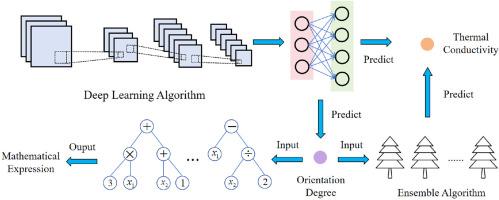利用深度学习和集合学习相结合的方法预测带有一维定向填料的聚合物复合材料的导热性能
IF 9.6
Q1 COMPUTER SCIENCE, ARTIFICIAL INTELLIGENCE
引用次数: 0
摘要
带有一维(1D)取向填料的聚合物复合材料具有公认的高热导率(TC),被广泛用于冷却电子元件。然而,由于填料取向对复合材料的热导率有很大影响,因此对带有一维取向填料的复合材料的热导率进行预测是一项挑战。在本文中,我们采用深度学习和集合学习相结合的策略,高效、快速地预测带有一维取向填料的复合材料的热导率。首先,作为对照,我们使用卷积神经网络(CNN)模型预测了一维碳纤维-环氧树脂复合材料的热导率,测试集上的 R 平方(R2)达到了 0.924。但是,对于由不同基材和填料组成的复合材料,CNN 模型需要重新训练,这极大地浪费了计算资源。因此,我们定义了一个描述符 "方向度(Od)"来定量描述一维填料的空间分布。我们使用 CNN 模型来预测这一结构参数,在测试集上的准确率 R2 可以达到 0.950。以 Od 为特征,使用随机森林回归(RFR)预测 TC,在测试集上的准确率 R2 达到 0.954,高于 CNN 对照组。我们进一步成功地将这一策略扩展到了由不同一维填料和矩阵组成的复合材料上,只需训练一个 CNN 模型和一个 RFR 模型即可实现快速准确的 TC 预测。该策略为基于机器学习的材料性能预测提供了宝贵的见解和指导。本文章由计算机程序翻译,如有差异,请以英文原文为准。

Predicting the thermal conductivity of polymer composites with one-dimensional oriented fillers using the combination of deep learning and ensemble learning
Polymer composites with one-dimensional (1D) oriented fillers, recognized for their high thermal conductivity (TC), are extensively utilized in cooling electronic components. However, the prediction of the TC of composites with 1D oriented fillers poses a challenge due to the significant impact of filler orientation on composite TC. In this paper, we use a strategy that combines deep learning and ensemble learning to efficiently and quickly predict the TC of composites with 1D oriented fillers. First, as a control, we used convolutional neural network (CNN) model to predict the TC of 1D carbon fiber-epoxy composite, and the R-squared (R2) on the test set reached 0.924. However, for composites consist of different matrices and fillers, the CNN model needs to be retrained, which greatly wastes computing resources. Therefore, we define a descriptor ‘Orientation degree (Od)’ to quantitatively describe the spatial distribution of the 1D fillers. CNN model was used to predict this structural parameter, the accuracy R2 can reach 0.950 on the test set. Using Od as a feature, random forest regression (RFR) was used to predict the TC, and the accuracy R2 reached 0.954 on the test set, which was higher than that of CNN control group. We further successfully extended this strategy to composites consist of different 1D fillers and matrices, and only one CNN model and one RFR model needed to be trained to achieve fast and accurate TC prediction. This strategy provides valuable insights and guidance for machine learning-based material property prediction.
求助全文
通过发布文献求助,成功后即可免费获取论文全文。
去求助
来源期刊

Energy and AI
Engineering-Engineering (miscellaneous)
CiteScore
16.50
自引率
0.00%
发文量
64
审稿时长
56 days
 求助内容:
求助内容: 应助结果提醒方式:
应助结果提醒方式:


